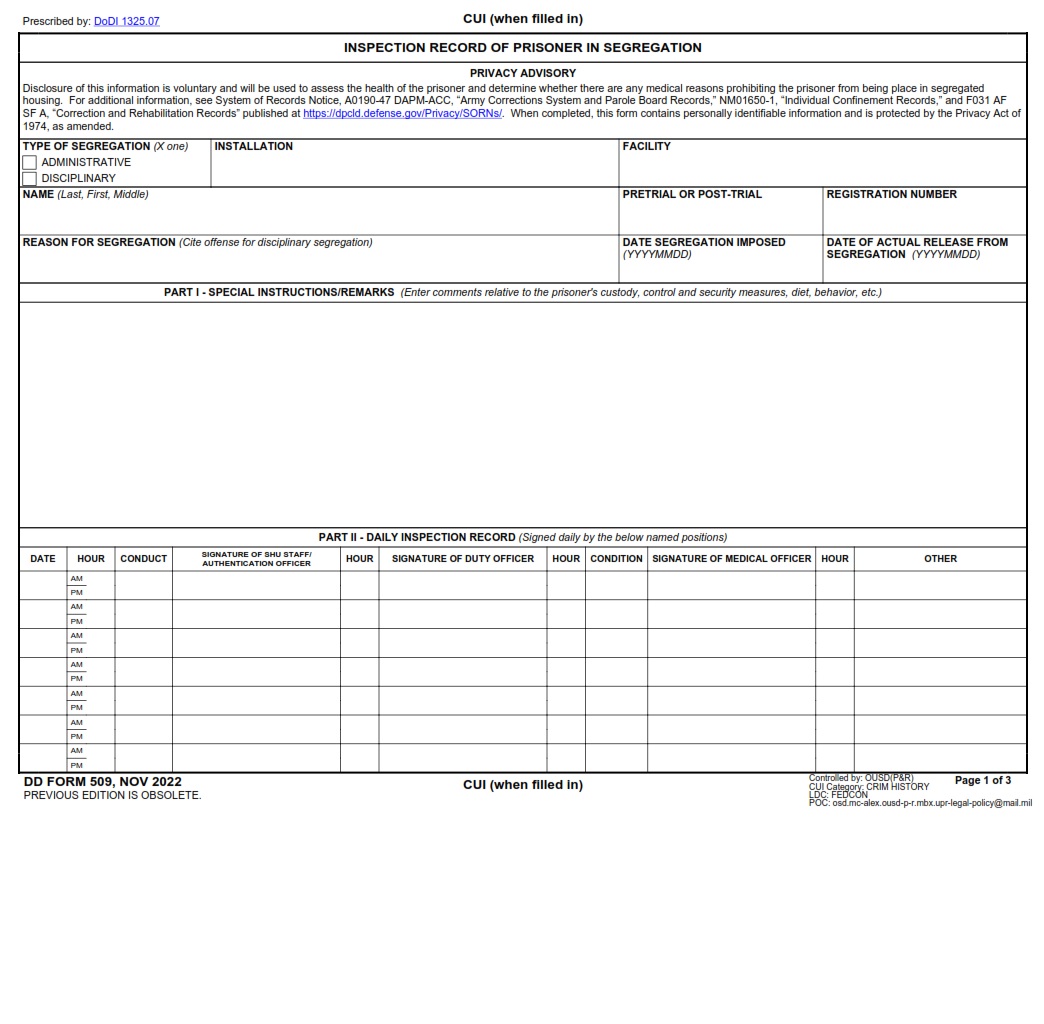Table of Contents
FREE-ONLINE-FORMS.COM – DD Form 509 – Inspection Record of Prisoner in Segregation – Behind the steel bars and guarded walls, a hidden world exists within our prisons. In this secret realm, prisoners are confined to segregation units – isolated from the general population for various reasons. The DD Form 509 is their lifeline to the outside world, meticulously documenting their every move and condition. This inspection record holds the power to expose the flaws in our criminal justice system, revealing stories of abuse, neglect, and defiance that have long been concealed from public view. Join us as we explore the dark corners of prisoner segregation through the lens of DD Form 509 – a chilling glimpse into an often overlooked aspect of incarceration.
Imagine spending your days in a cell no larger than a parking space, with nothing but concrete walls for company. Imagine being cut off from friends and family for weeks or even months at a time, living under constant surveillance by prison staff who dictate every aspect of your existence. This is the reality faced by thousands of prisoners held in segregation units across America – invisible lives trapped behind locked doors. The DD Form 509 serves as both their testimony and silent plea for help; it reveals not only their physical conditions but also uncovers tales of resilience and resistance against an unjust system that believes isolation can be rehabilitative.
Download DD Form 509 – Inspection Record of Prisoner in Segregation
| Form Number | DD Form 509 |
| Form Title | Inspection Record of Prisoner in Segregation |
| Edition Date | 11/3/2022 |
| File Size | 84 KB |
What is a DD Form 509?
The DD Form 509, also known as the Inspection Record of Prisoner in Segregation, is a vital document utilized by correctional facilities to record and track important information regarding prisoners held in segregation. This form serves as a comprehensive record that includes details such as the prisoner’s personal information, reason for confinement, medical condition, daily activities, and any incidents or disciplinary actions taken during their segregation period.
One of the primary purposes of the DD Form 509 is to ensure oversight and accountability in the management of segregated prisoners. By requiring correctional staff to document various aspects of a prisoner’s time in segregation, this form helps prevent abuses or neglect within these facilities. Moreover, it facilitates communication among staff members by providing them with a centralized source of information about each individual held in segregation.
For both detainees and facility personnel alike, the DD Form 509 plays a crucial role in safeguarding individuals’ rights and maintaining order within correctional institutions. It acts as both an administrative tool for monitoring prisoner behavior and an instrument for transparency and accountability. By implementing such records protocols like this form, prisons can work towards greater fairness and adherence to prescribed regulations.
Where Can I Find a DD Form 509?
If you are in search of a DD Form 509, look no further! This essential document used by the military to record the inspection details of prisoners in segregation can typically be found in various locations. First and foremost, your best bet would be to reach out to your local military base or installation. The administration or personnel office should have copies readily available for individuals who require them.
In addition, many online resources offer downloadable versions of the DD Form 509. Websites such as the Defense Technical Information Center (DTIC) provide access to a wide array of military forms, including this particular one. Simply navigate their user-friendly website and enter DD Form 509 in the search bar to locate and download the form as needed.
For those with limited internet access or unable to visit a military site physically, reaching out directly to your commanding officer or supervisor could also prove helpful. They may be able to provide you with a physical copy if they have one on hand or point you in the right direction.
Remember, having an up-to-date DD Form 509 is crucial when documenting prisoner inspections while they are under confinement. Whether you visit a local military base or utilize online resources like DTIC, ensuring accessibility to this form is imperative for proper enforcement and compliance within correctional facilities.
DD Form 509 – Inspection Record of Prisoner in Segregation
The DD Form 509, also known as the Inspection Record of Prisoner in Segregation, plays a crucial role in maintaining accountability and ensuring proper treatment of prisoners in segregation units. This form is used to document regular inspections of prisoners held in segregation, providing a detailed record of their physical condition, mental state, and any notable incidents or observations.
While some may view this form as simply bureaucratic paperwork, it actually serves a vital purpose in ensuring the rights and well-being of incarcerated individuals. By mandating regular inspections and thorough documentation, the DD Form 509 holds prison staff accountable for their treatment of segregated prisoners. It serves as an important tool for monitoring potential abuses or neglect, while also allowing medical professionals to identify health concerns that may arise due to prolonged isolation.
Moreover, the inspection records on this form are not just limited to documenting physical conditions; they also highlight any signs of psychological distress or deteriorating mental health among segregated prisoners. These records provide valuable insight into the impact that extended periods of isolation can have on an individual’s mental well-being. By analyzing these documented observations over time, policymakers and researchers gain a deeper understanding of the effects of solitary confinement on prisoner rehabilitation and overall prison practices.
In conclusion, while it may be easy to overlook the importance of forms such as the DD Form 509 Inspection Record of Prisoner in Segregation amidst discussions surrounding prison reform and inmate rights, they play a significant role in holding institutions accountable for their actions.

